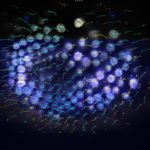Link to Pubmed [PMID] – 30318352
Curr. Biol. 2018 Oct;28(20):3342-3351.e3
Polar cell growth is a conserved morphogenetic process needed for survival, mating, and infection [1, 2]. It typically implicates the assembly and spatial stabilization of a cortical polar domain of the active form of a small GTPase of the Rho family, such as Cdc42, which promotes cytoskeleton assembly and secretion needed for local surface expansion [3-6]. In multiple physiological instances, polarity domains may switch from being spatially unstable, exhibiting a wandering behavior around the cell surface, to being stable at a fixed cellular location [7-11]. Here, we show that the rate of surface growth may be a key determinant in controlling the spatial stability of active Cdc42 domains. Reducing the growth rate of single rod-shaped fission yeast cells using chemical, genetic, and mechanical means systematically causes polar domains to detach from cell tips and oscillate around the cell surface within minutes. Conversely, an abrupt increase in growth rate improves domain stabilization. A candidate screen identifies vesicular transport along actin cables as an important module mediating this process. Similar behavior observed in distant filamentous fungi suggests that this positive feedback between growth and polarity could represent a basal property of eukaryotic polarization, promoting persistent polar growth as well as growth redirection with respect to the mechanical environment of cells.

